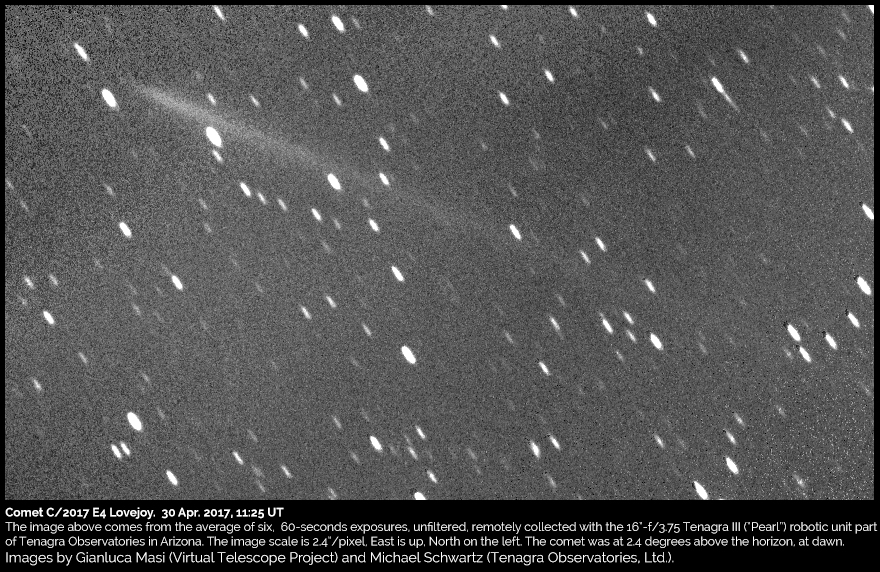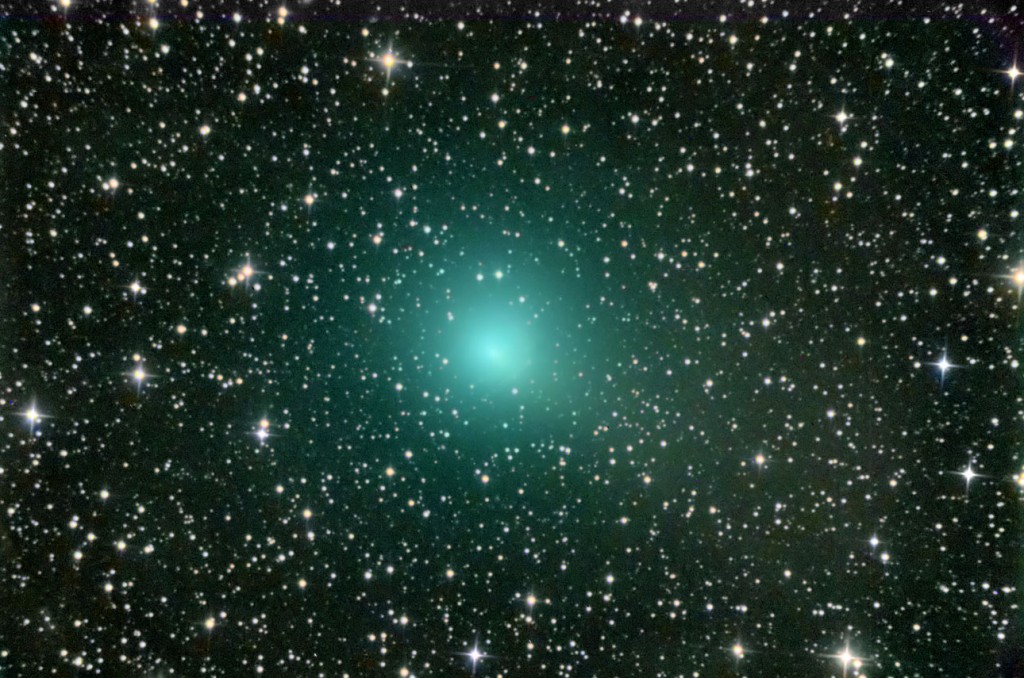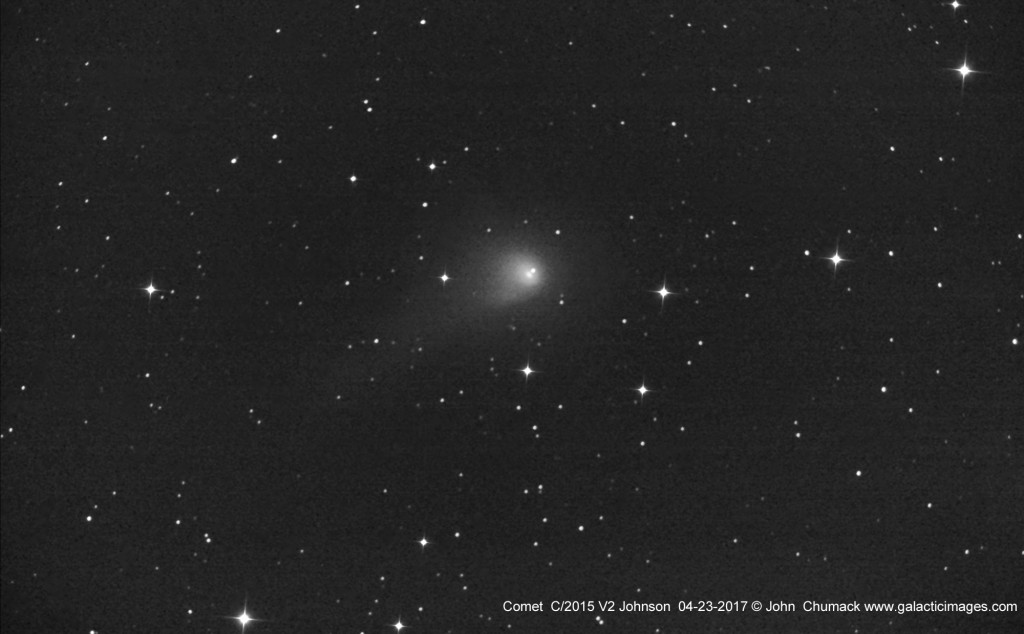ALPO COMET NEWS FOR MAY 2017
2017-May-3
April was a busy month for the Comet Section as 4 comets were observed visually and 10 comets imaged with CCDs. The most exciting comet of the month was C/2017 E4 (Lovejoy). Discovered in March, this comet rapidly brightened to 6th magnitude before beginning a sudden fade. Gianluca Masi and Michael Schwartz observed it on 14 nights during April. Their latest observation shows a comet in distress and one whose nucleus may have already disintegrated. Most disintegrators are dynamically new so Lovejoy is a little strange in that it is a dynamically old comet. Still, there are a few examples of dynamically old comets that have disintegrated including C/1996 Q1 (Tabur) and even periodic comets 3P/Biela and 20D/Westphal.
Last month the Comet Section received comet magnitude estimates for comets 41P/Tuttle-Giacobini-Kresak, C/2015 ER61 (PANSTARRS), C/2015 V2 (Johnson) and C/2017 E4 (Lovejoy) from Salvador Aguirre, Carl Hergenrother and Willian Souza. In addition to C/2017 E4 (Lovejoy), CCD images were also received for comets 41P/Tuttle-Giacobini-Kresak, 45P/Honda-Mrkos-Pajdusakova, 71P/Clark, 73P/Schwassmann-Wachmann 3, 213P/Van Ness, 315P/LONEOS, C/2013 X1 (PANSTARRS), C/2015 ER61 (PANSTARRS) and C/2015 V2 (Johnson) from Charles Bell, John Chumack, Carl Hergenrother, Manos Kardasis, Gianluca Masi, Richard Owens, John D. Sabia, Chris Schur and Michael Schwartz.
This May morning observers will be able to follow a few comets in small telescopes as C/2015 ER61 (PANSTARRS) and C/2015 V2 (Johnson) are both 7th to 8th magnitude. Larger telescope users will be able to follow fading 41P/Tuttle-Giacobini-Kresak and brightening 71P/Clark.
Morning Comets
41P/Tuttle-Giacobini-Kresak [Perihelion on 2017 Apr 12 at 1.05 au]
41P/T-G-K approached to within 0.14 au of Earth on April 1 when it brightened to around magnitude 7.0. There was hope that the comet would experience an outburst like it did in 1973 but so far no luck. The comet is currently fading and is already a difficult object for many observers due to its low surface brightness coma. This month 41P will move through Hercules (May 1), Lyra (1-16) and Hercules (16-31) as it moves away from the Sun (1.08 to 1.23 au) and Earth (0.19 to 0.29 au). It is a morning object all month with an elongation that increases from 105 to 133 degrees. It starts the month between magnitude 7.5 and 8.0 and may fade to 9.0 to 10.0 by the end of the month.
Below is an image of 41P obtained by Chris Schur on April 29.
71P/Clark [Perihelion on 2017 June 30 at 1.59 au]
Michael Clark discovered this comet photographically in 1973 from Mount John University Observatory in New Zealand. With an orbital period of 5.6 years, 2017 marks this comet’s 8th observed return. Clark will start the month in Ophiuchus (May 1-22) at 11th magnitude before moving into Scorpius (23-31) and brightening to around 10th magnitude. Its distance from the Sun will shrink from 1.68 to 1.61 au. With a geocentric distance that drops from 0.74 to 0.60 au this month, the comet will come as close to the Earth as it can on its present orbit.
C/2015 ER61 (PANSTARRS) [Perihelion on 2017 May 9 at 1.04 au]
Comet PANSTARRS experienced a 2+ magnitude outburst in early April that brought it close to magnitude 6.0. Since then the comet has settled back down to its expected brightness of magnitude 7.5 to 8.0. It will reach perihelion on May 9 at 1.04 au from the Sun but be rather far from Earth at 1.20 to 1.37 au from Earth. A morning sky object, it will be in Pisces all month long as its elongation shrinks from 56 to 52 degrees. Barring further outbursts, PANSTARRS should remain around its current magnitude all May.
C/2015 V2 (Johnson) [Perihelion on 2017 June 12 at 1.64 au]
Comet Johnson is a little more than a month from its closest approach to Earth on June 5 at 0.81 au and perihelion on June 12 at 1.64 au. There has been some controversy on the comets-ml Yahoo group as to exactly how bright this comet. Observers using binoculars (such as myself) have reported the comet as bright at magnitude 7.6. Larger telescope observers are estimating the comet to be as faint as magnitude 9.0. While the comet is obvious to me in 10×50 binoculars, it is possible that my estimates are too bright due to contamination from a very bright dust tail that is unresolvable in small binoculars. Large aperture observers can differentiate the coma from the tail resulting in fainter total magnitude measurements. Regardless, Johnson should continue to brighten by another magnitude this month as it approaches the Sun (1.73 to 1.64 au) and Earth (1.01 to 0.82 au). It is still a morning object as its moves through Hercules (May 1-2) and Bootes (2-31).
As always, the Comet Section is happy to receive all comet observations, whether images, drawings or magnitude estimates.
- Carl Hergenrother (ALPO Comet Section Coordinator)






